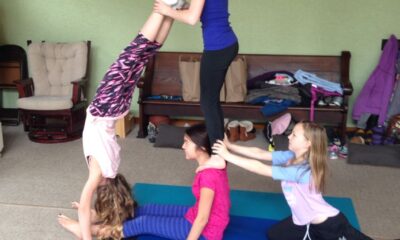GENERAL
How to Create the Ideal Weekly Routine Using Dog Grooming, Boarding, and Daycare

Introduction
Dogs thrive when they have a predictable routine filled with enrichment, rest, and proper care. While pet parents often turn to dog boarding, dog daycare, or dog grooming services as needed, building these services into a thoughtful weekly or monthly schedule can make a huge difference in your dog’s well-being.
When combined effectively, these services offer a complete support system for your dog—addressing their physical health, mental stimulation, social engagement, and hygiene. Planning ahead allows you to meet their needs consistently, reduce stress during transitions, and free up time in your schedule as well.
B&S Boarding and Grooming Kennels provides all three essential services under one roof, making it easier for pet owners to design a structured routine that suits their dog’s lifestyle. In this article, we’ll walk through what an ideal care schedule might look like and how to tailor it based on your dog’s age, temperament, and daily rhythm.
Table of Contents
Monday: Kick Off the Week with Daycare
After a weekend spent relaxing with the family or lounging around at home, many dogs have energy to burn on Monday morning. Dog daycare is the perfect way to ease into the week, offering structured play, socialization, and exercise that sets a positive tone for the days ahead.
A full day of daycare keeps your dog mentally and physically engaged while giving you a break from midday walks or managing their boredom while you work. Dogs who attend daycare regularly often display better behavior at home and sleep more soundly after a day of healthy stimulation.
It’s also helpful to use daycare as a way to assess how your dog interacts with others or manages time away from home, which can be a stepping stone toward future boarding stays.
Tuesday: Recharge with a Home Day
Following an active day, your dog benefits from a quieter Tuesday. Time to relax at home gives them space to rest their muscles and avoid overstimulation. This is especially important for younger dogs still growing or older dogs who need to conserve energy.
Use this day to monitor your dog’s mood and behavior after daycare. Are they calm and satisfied? Still energetic? Keeping track of their responses can help fine-tune your schedule over time.
If your dog tends to get dirty during outdoor play or daycare, consider planning a midweek dog grooming appointment later in the week to maintain cleanliness and coat health.
Wednesday: Midweek Grooming and Wellness Check
Grooming isn’t just about keeping your dog looking good—it plays a major role in their physical health. A professional dog grooming session can help with skin maintenance, coat condition, nail trimming, ear cleaning, and early detection of any irritations or parasites.
Midweek is a smart time to schedule a grooming session, especially if your dog has had physical activity earlier in the week or if you’re preparing for the weekend. By this point, coat oils, dirt, and debris from daycare or playtime may have started to build up.
Regular grooming also prevents matting and makes seasonal shedding easier to manage. Whether you have a short-haired breed or a long-coated dog, keeping a grooming routine in place avoids discomfort and keeps your pet looking and feeling their best.
Thursday: Second Daycare Session
By Thursday, your dog may be ready for another round of stimulation and social interaction. Scheduling a second dog daycare day allows your pet to stay consistent with their routine and avoid long gaps between activity periods.
This second visit reinforces social skills, provides continued exercise, and helps reduce restlessness heading into the weekend. Dogs who attend daycare multiple times a week often build stronger bonds with other dogs and caregivers, making each visit smoother and more enjoyable.
Daycare is especially valuable for dogs prone to separation anxiety or boredom-based behaviors, offering structure and companionship while you’re occupied with work or other responsibilities.
Friday: Prep for the Weekend with Boarding or Rest
Fridays are often a transition point—either preparing for weekend travel or winding down after a busy week. If you’re heading out of town, dog boarding can begin in the evening. For dogs who’ve already attended daycare or grooming at the facility, transitioning into a boarding stay is easy and familiar.
Because your dog already knows the environment and the caregivers, they’re more likely to feel calm and relaxed while staying overnight. Pack your dog’s usual food, medications, and a familiar item like a blanket or toy to maintain comfort during their boarding experience.
If your plans are local, Friday can be a home day where your dog enjoys rest after a busy week. Knowing they’ve had quality interaction, grooming, and care earlier in the week, you can spend time together knowing their needs have already been met.
Saturday–Sunday: Flex Days for Family or Extended Boarding
Weekends can vary depending on your lifestyle. Some families want to keep their dog close during weekend activities, while others use this time to catch up on travel or errands. Either way, your dog can benefit from flexibility in their care.
If your dog is in boarding, they’ll continue receiving consistent attention, structured playtime, and safe accommodations. If they’re at home, consider a long walk or relaxed outing to reinforce the bond and help them expend weekend energy.
For dogs that are groomed on a bi-weekly or monthly schedule, weekends may also be a convenient time for appointments, especially before holidays, visitors, or public events where you want your dog looking their best.
Customizing the Routine for Your Dog
The ideal routine depends on your dog’s breed, age, and personality. High-energy breeds may need two to three daycare days per week, while seniors might prefer less frequent activity but more consistent grooming.
For example:
- Puppies might benefit from shorter daycare visits and regular bathing to acclimate to services.
- Older dogs may need less social time but benefit greatly from scheduled grooming and quiet boarding options.
- Dogs with skin conditions or allergies may require more frequent baths and monitoring.
Watch for signs that your dog is thriving—calmness after daycare, less itching after bathing, and eagerness to return to the facility are all positive indicators that your plan is working.
B&S Boarding and Grooming Kennels provides the flexibility and care coordination to help tailor a weekly or monthly routine to your dog’s specific needs.
Conclusion
Creating a balanced care routine for your dog doesn’t have to be complicated. By integrating dog grooming, dog daycare, and dog boarding into your weekly schedule, you ensure your dog receives the physical attention, mental stimulation, and emotional support they need to thrive.
When planned strategically, these services don’t just meet your dog’s needs—they enhance their overall quality of life. Whether it’s through consistent grooming for skin health, daycare for social interaction, or reliable boarding during travel, a thoughtful routine is one of the best gifts you can give your pet.
B&S Boarding and Grooming Kennels is here to help you build that routine with care, expertise, and a deep understanding of what dogs need to stay happy, healthy, and well-adjusted.
-

 GENERAL2 months ago
GENERAL2 months agoUncovering the World of кинокрадко: The Dark Side of Film Piracy
-

 GENERAL1 month ago
GENERAL1 month agoUnveiling the Art of преводсч: How Translators Bridge Language Barriers
-

 YOGA1 year ago
YOGA1 year ago4 Person Yoga Poses for Beginners
-

 GENERAL2 months ago
GENERAL2 months agoThe Journey of iamnobody89757: From Anonymous User to Internet Sensation


























